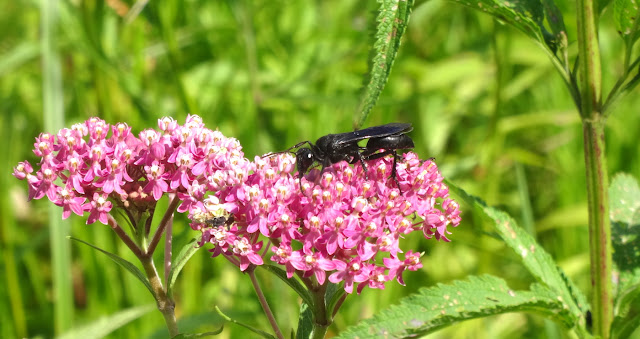Showing posts with label burrow. Show all posts
Showing posts with label burrow. Show all posts
10/25/2021
muskrats chasing ducks
As the Mallards swim around the pond, feeding on plants growing at the edge, the muskrats chase the ducks. The water mammals don't want to share with the birds. Muskrats' burrow or tunnel system is nearby, with an underwater entrance.
8/19/2020
black wasp
I was surprised and apprehensive to see this big black wasp on a milkweed flower near the pond. It was alarming because of its size (over one inch) but is not a pest to harm people. This Great Black Wasp Sphex pennsylvanicus, looks iridescent violet-black with smoky transparent wings that have a violet sheen. They visit flowers to feed on nectar and pollen; no harm to the plants.
The female Black Wasp digs a burrow in the ground to reproduce her kind. She hunts katydids, paralyzes them, and places several in the burrow. She then lays eggs in the burrow. They hatch into larvae. They have a ready meal, quietly growing into adult Black Wasps.
6/12/2020
Alsike Clover
 Clover is a forage crop around the world. But it readily escapes cultivation, so it is common in meadows and in disturbed places. This pond and surrounding wetland was disturbed during transition to a neighborhood, and some native plant seed was sown. So, we have clover.
Clover is a forage crop around the world. But it readily escapes cultivation, so it is common in meadows and in disturbed places. This pond and surrounding wetland was disturbed during transition to a neighborhood, and some native plant seed was sown. So, we have clover.Alsike Clover Trifolium hybridum flowers are light pink turning darker pink with age, giving the head a distinct two-tone color pattern as lower blossoms on the globe mature first.
Clover is one of the main nectar sources for honeybees. The resident Muskrats are very fond of clover. We see them swimming across the pond, picking a bunch of clover stems and leaves with flowers, then swimming back across the pond to their burrow.
5/15/2020
muskrat take-in dinner
This adult Muskrat is probably taking a meal home to the nest. They can bear more than one litter per year. Carrying this much food, rather than eating on the spot, suggests this adult has a litter unable yet to feed on their own. In Minnesota, Muskrats, Ondatra zibethicus, eat vegetation they they find and harvest in wetlands. They weigh 2 to 5 pounds, and live in burrows or domed nests on the edge of ponds or streams.
Subscribe to:
Comments (Atom)



